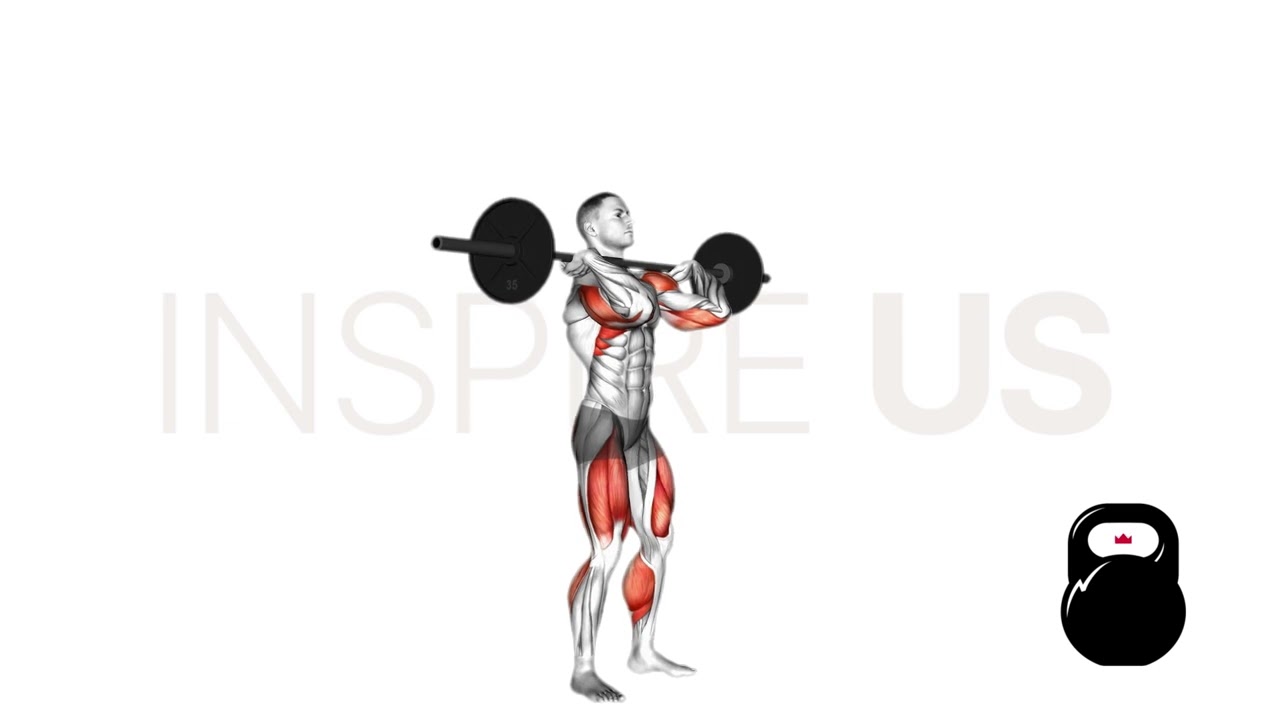Barbell Push Press: Benefits, Muscles Worked, and More
Considered the more explosive brother to the overhead press; the barbell push press is a highly effective full-body exercise favored by athletes and functional fitness enthusiasts alike.
Continue reading to learn how to perform the push press safely and achieve its many benefits.
To put it short however, the push press can be said to be an explosive full-body exercise where the muscles of the legs are utilized to generate force and push a barbell over the lifter’s head - training not only the shoulders and arms, but also the lower body as well.
What is the Barbell Push Press?
In more technical terms, the barbell push press is a multi-joint compound exercise primarily used for developing explosive power throughout the entire body.
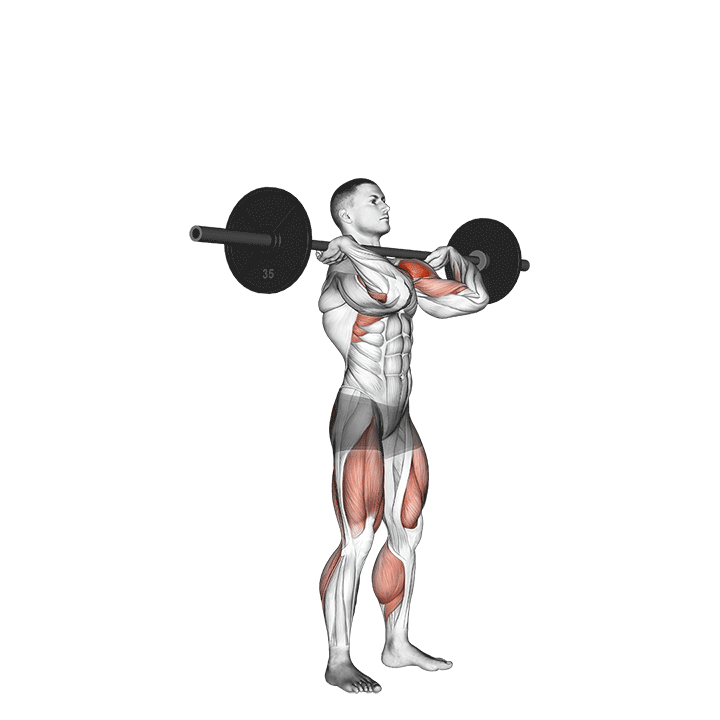
It is often with a moderate to heavy amount of weight and a comparatively lesser amount of volume, as each repetition is considerably taxing on the body.
The barbell push press is usually programmed as a secondary compound exercise alongside other dynamic types of training, such as plyometrics or interval training.
Who Should do the Barbell Push Press?
The barbell push press requires an intermediate understanding of proper exercise mechanics, as well as enough bodily coordination to perform safely.
As such, it is best for lifters of at least an intermediate level to perform the exercise, as they possess sufficient coordination and familiarity with resistance training.
How to do the Barbell Push Press
To perform a repetition of the barbell push press, the lifter will stand with their feet planted shoulder-width apart and a loaded barbell racked atop their clavicles, hands securing it at wider than shoulder-width distance.
Entering a quarter squat stance, the lifter will angle their elbows so as to ensure the barbell is thrust immediately upwards, rather than backwards.
Pushing through the heels and extending the knees simultaneously, the lifter will push the bar over their head in an explosive manner - ensuring that the arms are fully extended overhead.
From this point, the repetition is considered to be complete.
What Muscles are Worked by the Barbell Push Press?
The barbell push press recruits practically every single muscle group found in the body, but not all of them to the same capacity.
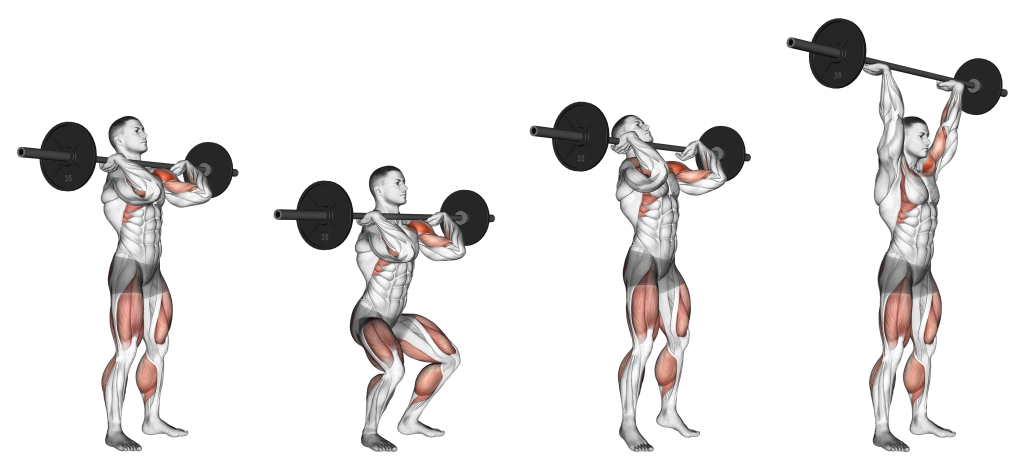
Those that are engaged to the greatest intensity are called primary mover muscles, whereas those in a lesser or only isometric capacity are called secondary movers and stabilizers.
Primary Mover Muscles
The barbell push press primarily works the deltoids, the triceps brachii, the quadriceps femoris, the glutes and the pectoral muscles.
Each of these muscles plays an important role in the explosive vertical push that is characteristic of the exercise, and as such will also be the muscles that develop the most from regular push press performance.
Secondary Mover Muscles and Stabilizers
Other muscle groups activated by the barbell push press are those of the core, the erector spinae, the serratus, the hip flexors and the hamstrings.
What are the Benefits of the Barbell Push Press?
Apart from being great for the lifter’s health as a whole, the barbell push press can also offer a few further benefits that are particularly useful for lifters wishing to grow their shoulder muscles - or athletes who want to take their game to the next level.
Significant Full-Body Power Development
Because the barbell push press demands rapid force development from not only the shoulders and arms but also the lower body, it is considered to be an excellent tool for building up explosiveness and power throughout the entire body.
Strongman competitors, olympic weightlifters and nearly all other types of athletes will see a significant improvement in their physical performance from including the barbell push press into their training routine.
In order to optimize the push press for building explosiveness, lifters should strive to focus more on quality repetitions and sets of lesser volume but a higher amount of weight.
Excellent for Supra-Loading the Deltoids
It should come as no surprise that the barbell push press allows lifters to move significantly more weight than they would otherwise be able to with a strict overhead press.
This creates the opportunity for loading the deltoids with far more resistance than they could lift on their own - allowing for greater strength development and helping the lifter acclimatize to moving heavy amounts of weight.
Teaches Balance and Coordination
Like many other highly dynamic movements, the barbell push press will help lifters develop the necessary skills for effective locomotion - especially those of balance and physical coordination, as the push press will require the lifter to execute numerous technically-complex movements in rapid fashion.
Combining the push press with other methodologies for improving soft athletic skills (like agility training and plyometrics) will help create a technically-proficient and skilled athlete.
Perfect for Athletes and Functional Fitness
All of the aforementioned benefits add up to one conclusion: the barbell push press is excellent for athletic training, as many Crossfit athletes will tell you.
Apart from building up strength, power and explosiveness throughout the body, the barbell push press improves soft skills like proprioception and coordination - as well as helps familiarize the lifter with lifting a significant amount of weight over their head.
Common Barbell Push Press Mistakes
There is no doubt that the barbell push press is a complex exercise - but some mistakes are more common than others.
The following are those that are most likely to occur, regardless of whether the lifter is experienced or not.
Hyperextension of the Arms and Shoulders
While the push press is meant to be performed with the arms locked out at the end of the repetition (and it is dangerous not to), hyperextending the arms and shoulders by pushing the shoulder blades upwards will lead to a disadvantageous position of the shoulders within their socket joint.
This can easily lead to injury or a loss of control over the barbell - both of which are dangerous and should be avoided as much as possible.
In order to prevent hyperextension at the end of the push press, lifters should strive to keep their arms at the sides of their heads, and the elbows straight but not excessively locked out.
“Dipping” too Low
During the “dip” or the quarter squatting portion of the push press, lifters may accidentally lower themselves too much and ultimately reduce the amount of power translated into the upper body.
For the most efficient and effective movement, the lifter should focus more on bending their knees - and ensure that they are nowhere near parallel depth.
Pushing the Head Forward
Lifters new to the barbell push press may find themselves pushing their head forward and curving the upper back - forcing the arms to be extended behind the head, rather than to the sides.
This is potentially dangerous, as it can cause the weight of the barbell to rotate the shoulders backwards, as well as disbalance the lifter
When performing the barbell push press, the head should remain parallel to the arms, and the neck aligned with the rest of the spine.
Extending the Back or Pushing Out the Glutes
Just as pushing the head forwards can cause the body to become unbalanced and potentially injure the lifter, so too can extending the lower back or pushing the glutes backwards.
In both cases, the spine is pulled out of its safest alignment, and the body does not form a vertical line - as is the most optimized stance for push pressing effectively.
The back may extend slightly, but excessively curving it is a sign of poor abdominal muscle contraction, and poor form in general.
For the best results, lifters should brace their core and ensure that the lower back remains in a neutral position throughout the barbell push press repetition.
Barbell Push Press Alternatives
In case your coach says the push press is too dangerous for you - or if it just doesn’t meet your training needs - there are quite a number of potential alternatives that share many of the same characteristics.
1. Clean and Jerk
If the barbell push press is crawling, then the clean and jerk is sprinting.
The clean and jerk is a highly dynamic Olympic weightlifting staple that involves the lifter deadlifting a barbell from the floor and squat-pressing it over their head in a single fluid motion.
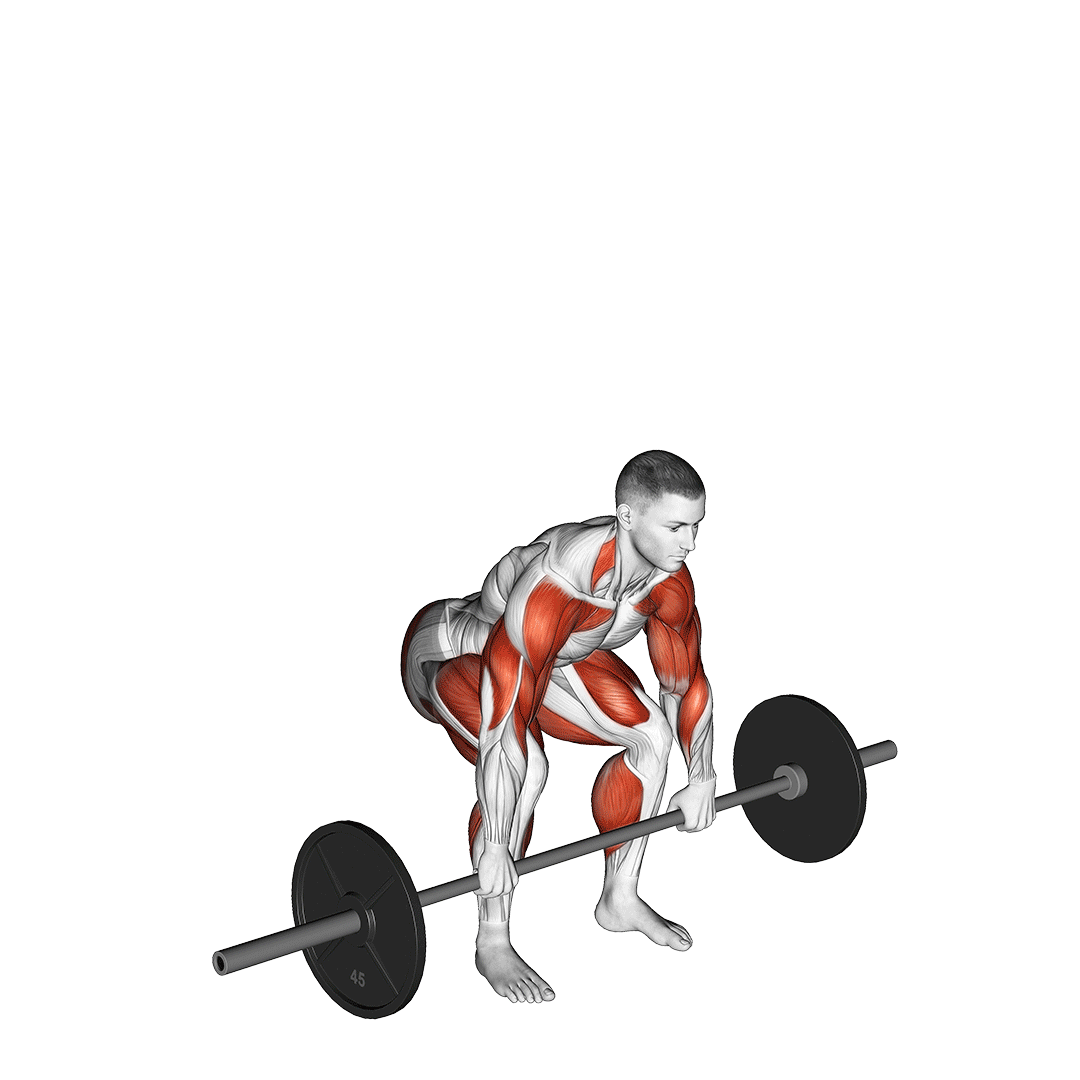
The clean and jerk is less of an alternative to the push press and more of a progression, as it does all of the same things that a barbell push press does and more.
2. Barbell Overhead Press
For lifters who wish to eliminate the usage of momentum and instead focus entirely on upper body muscle growth, the strict overhead press is the best bet.
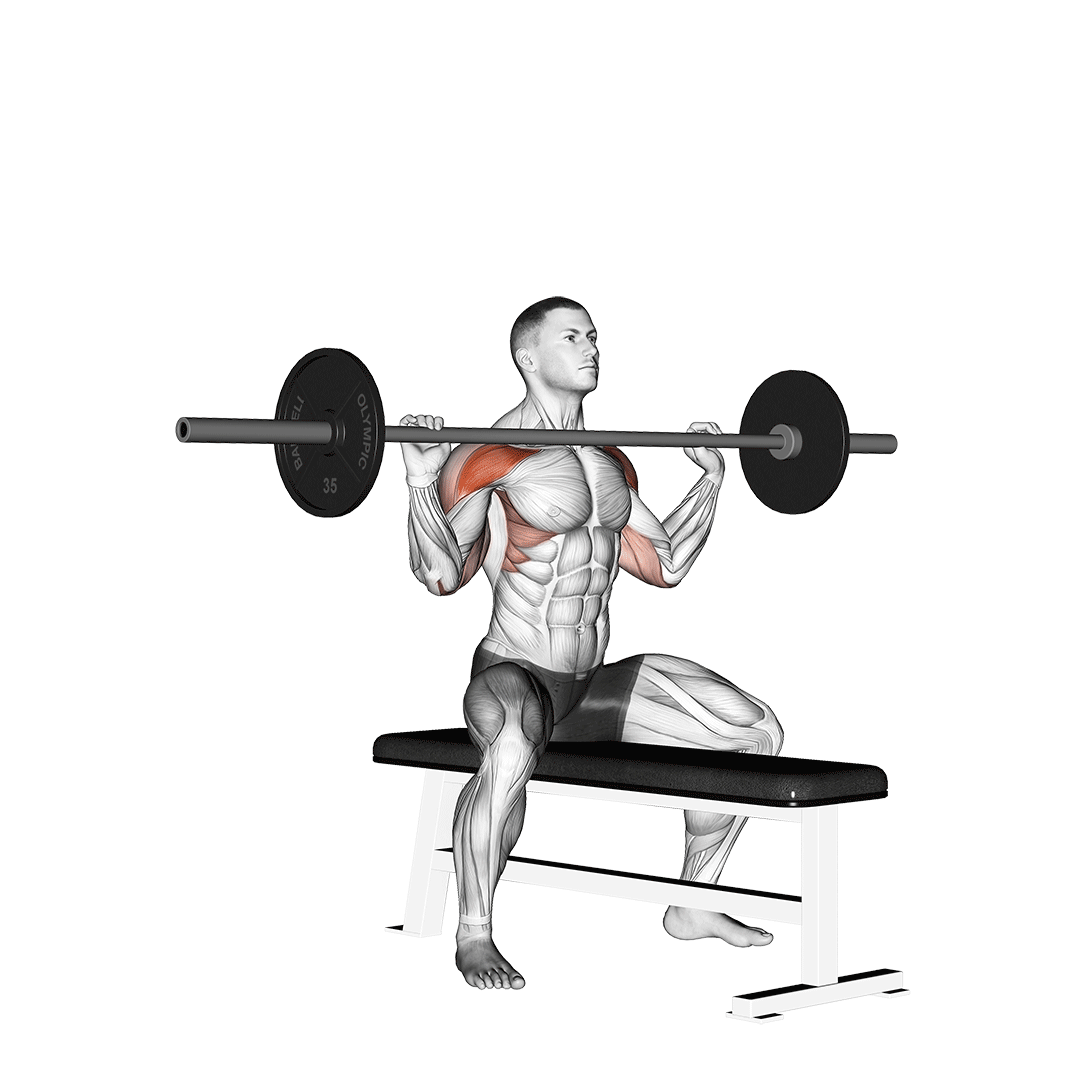
Unlike the barbell push press, the barbell overhead press does not involve any dipping or bending of the lower body, and instead derives all of the force from the deltoids and triceps alone.
While this means less weight is lifted, it also means that the shoulders and arms will grow far more effectively than with the push press - and with less of a risk of injury, to boot.
3. Barbell Push Jerk
The barbell push jerk is perhaps the most mechanically-similar exercise to the push press, as it is quite literally just a push press but with a deeper squat portion.

The push jerk may be used as a substitute to the barbell push press for lifters who wish to utilize more of their lower body’s musculature - resulting in greater developments therein and allowing even more weight to be lifted per repetition.
Frequently Asked Questions (FAQ)
Is the Push Press Necessary?
Not at all - any benefit that the push press may offer can also be achieved through an alternative exercise.
If you wish to retain the deltoid and tricep growth of the push press, you can perform the strict press instead. For the explosiveness and power, the clean and jerk is a viable alternative as well.
Is the Push Press "Cheating"?
The concept of "cheating" during an exercise is rather dubious, as it implies that the weightlifter is performing the movement in a way that was not intended in order to move more weight or perform more repetitions.
In the case of the push press, this is entirely besides the point as the push press is meant to be performed in a dynamic and explosive manner.
In short - no, the push press is not cheating.
What is the Difference Between a Press and a Push Press?
During a strict press, the lifter does not bend the knees and all the force is produced by the triceps and deltoids.
During a push press, the lifter utilizes a quarter squat, thereby generating momentum from their lower body. This means that the deltoids and triceps will be responsible for only a portion of the force output.
A Few Reminders
As effective and useful as the barbell push press is, it should not be the sole source of deltoid training volume in your workout. For a more balanced and aesthetically appealing body, include one or two deltoid isolation exercises as well.
It is also important to keep in mind that the push press can be dangerous when performed incorrectly, and that seeking out the advice of a professional coach before doing so can be beneficial.
References
1. Bishop, Chris & Chavda, Shyam & Turner, Anthony. (2017). Exercise Technique: The Push Press. Strength and Conditioning Journal. 40. 1. 10.1519/SSC.0000000000000321.
2. Loturco I, Pereira LA, Kobal R, Maldonado T, Piazzi AF, et al. (2016) Improving Sprint Performance in Soccer: Effectiveness of Jump Squat and Olympic Push Press Exercises. PLOS ONE 11(4): e0153958. https://doi.org/10.1371/journal.pone.0153958

